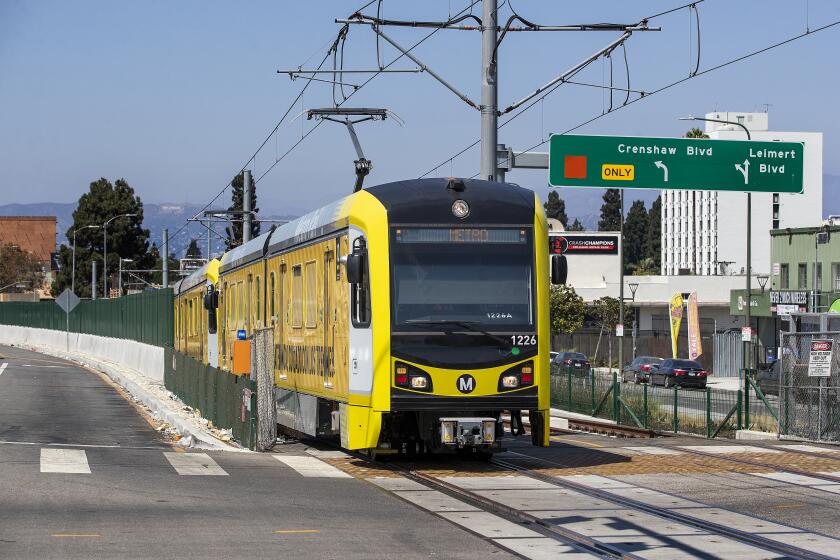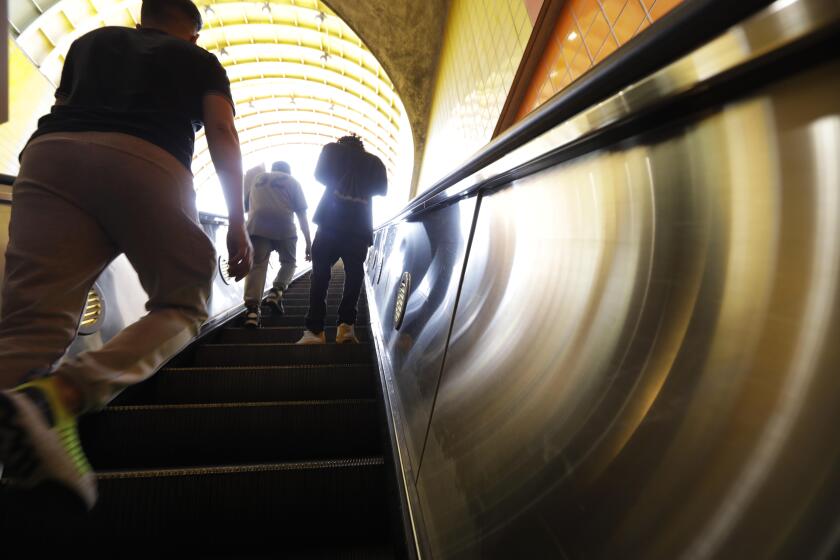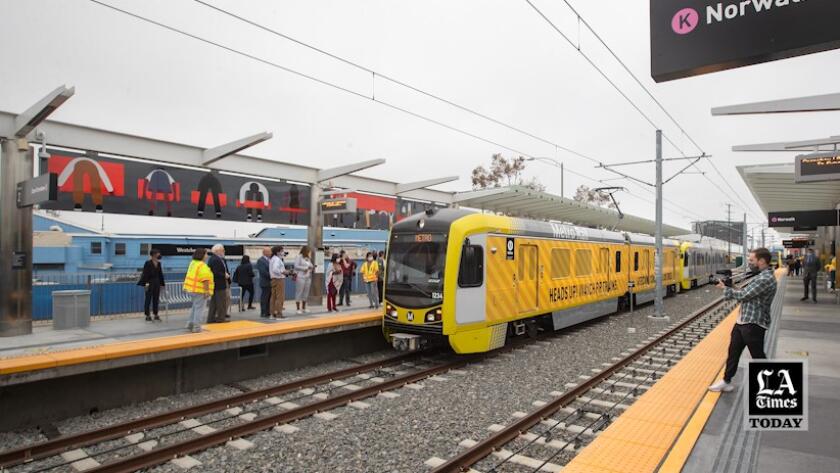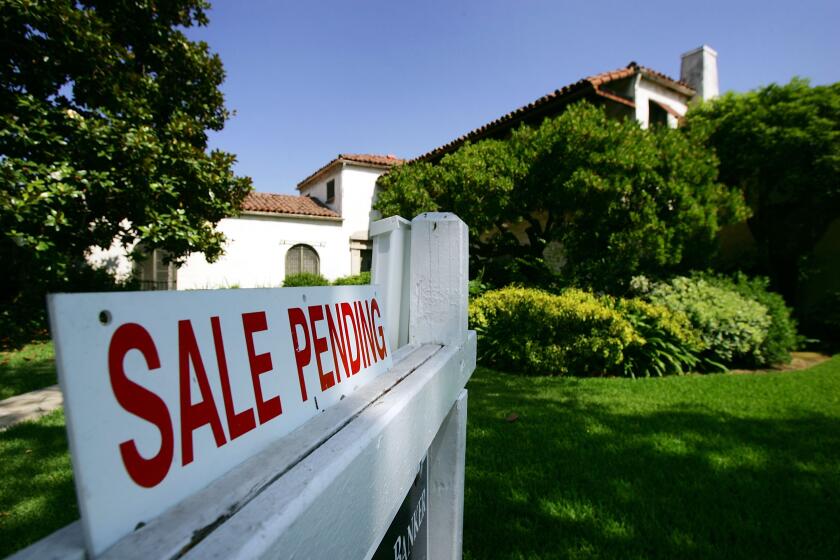For historic Black community, Crenshaw/LAX Line is ‘a blessing and a curse’
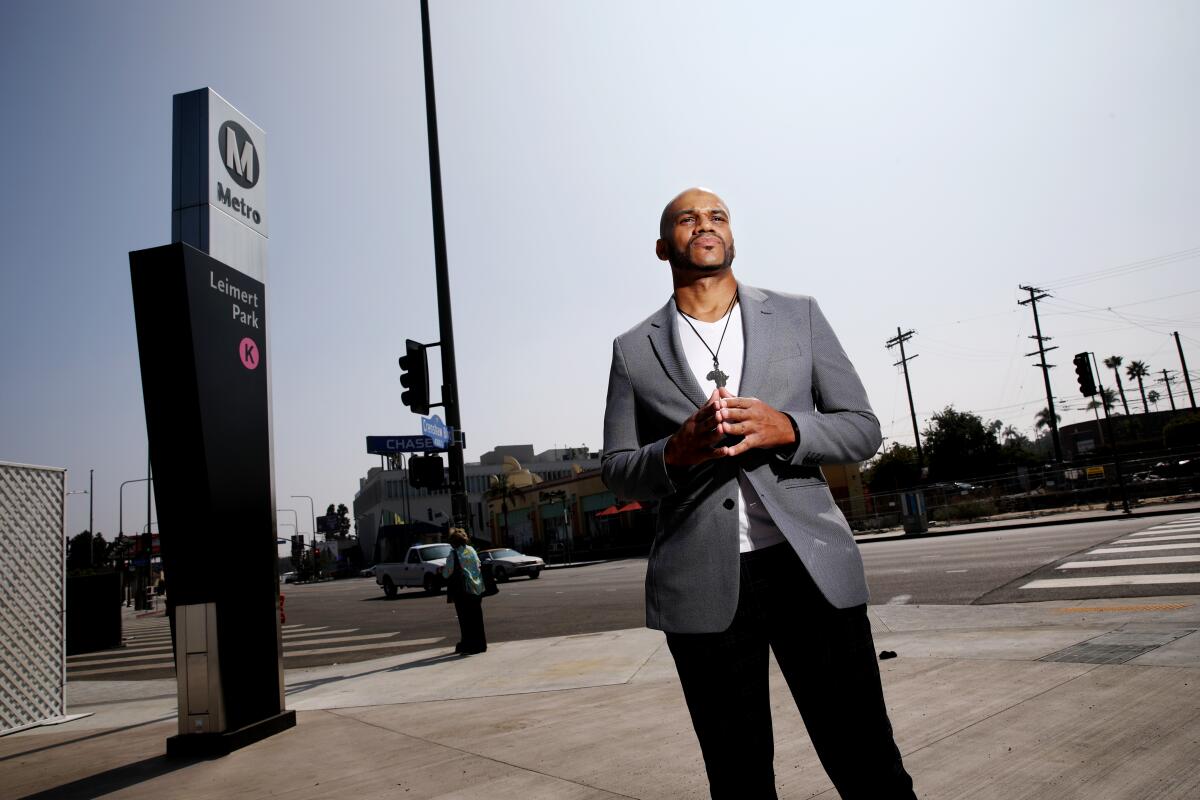
- Share via
Not far from the new Martin Luther King Jr. station along Crenshaw Boulevard, dozens of new apartments are under construction, a sign of the change washing over the historically Black district as Metro readies to open its seventh major rail line Friday.
The 8½-mile Crenshaw/LAX Line, known as the K Line, is being hailed by officials as the key to linking the region’s transit lines, at long last offering a connection into the Los Angeles International Airport, and with lines to downtown and the beach. The full line is not set to open until 2024, but officials will begin running the trains along seven stops, this first weekend for free.
For those who live and work close to the line, it is rapidly changing the neighborhoods around it, for better or worse. Investors are pouring billions of dollars to build commercial space and high-density and affordable housing in an area that has long been the heart of the Black middle class in Los Angeles, and a place of mom-and-pop businesses like dentists, hair salons, florists, art studios, grocery stores and restaurants.
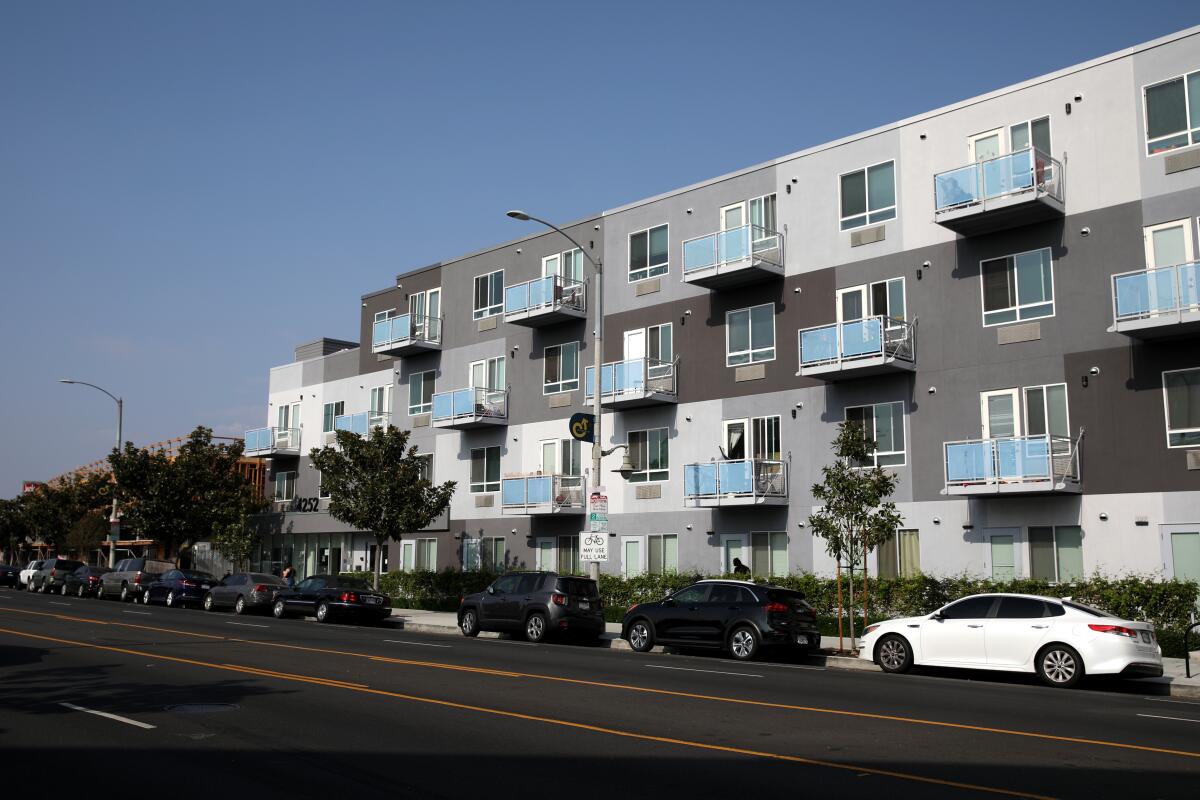
Victoria Fortson has watched the apartments rise across Crenshaw from the five-unit apartment and storefront she owns, the Right Choice Caribbean Market. She stocks yams, plantains, goat, sweet potatoes and meat pies, staples of Jamaica, her homeland. Currency from around the world hangs from a plate glass where the cashier sits.
A newly built four-story apartment has brought in a wave of new customers, few of them Black.
“It’s good for business,” Fortson said. “But I don’t want my culture to be dissipated.”
She has leased out a retail space next to a Black-owned cannabis dispensary, and hopes others Black entrepreneurs can buy or rent nearby. But she’s not hopeful. The forces of gentrification are unyielding.
Speculative investors are scrambling to get prime land along the rail line, much of which is favorably zoned for commercial space or high-density housing. Fortson wishes she and other locals could invest, but she can’t afford the soaring prices.
“The building beside me is now $2.5 million; a couple of years ago it was $535,000,” she said.
Even if she could buy in, she’d fear having to raise rents so high longtime residents would be displaced.
“Why not let us buy a piece of America?” she said. “It’s so sad.”
Metro is set to open much of the Crenshaw/LAX line Oct. 7, but it won’t connect to the airport until 2024, officials say.
About 5,000 residential units are either planned or under construction from the Expo Line station in West Adams to the Hyde Park area, said Jamie Brooks, an executive with the real estate services company CBRE Group. And the price of office space per square foot has shot up along the corridor, rising 36% in 2020 and 22% in 2021, according to the company — even as prices in the surrounding area fell because of the pandemic.

“A lot of the new investor interest has really been driven by the construction development of the $2.1-billion Crenshaw/LAX transit line,” he said. “That has kind of unlocked a lot of potential.”
A block away from Fortson sits the struggling Baldwin Hills Crenshaw Plaza. It was sold in 2021 to New York developers after a contentious bidding process and protests from neighborhood activists who hoped to acquire the property for a community-owned project. The developers plan to sink $1 billion into the 42-acre site. Organizers fear the office-centric development, with a K Line stop onsite, will further gentrify the neighborhood.
“It’s a blessing and a curse,” said Damien Goodmon, founder of the Crenshaw Subway Coalition. “It’s good that they’re finally finishing at least a significant portion of project because it’s taken a very long time and it’s been probably the most disruptive construction project I’ve seen.”
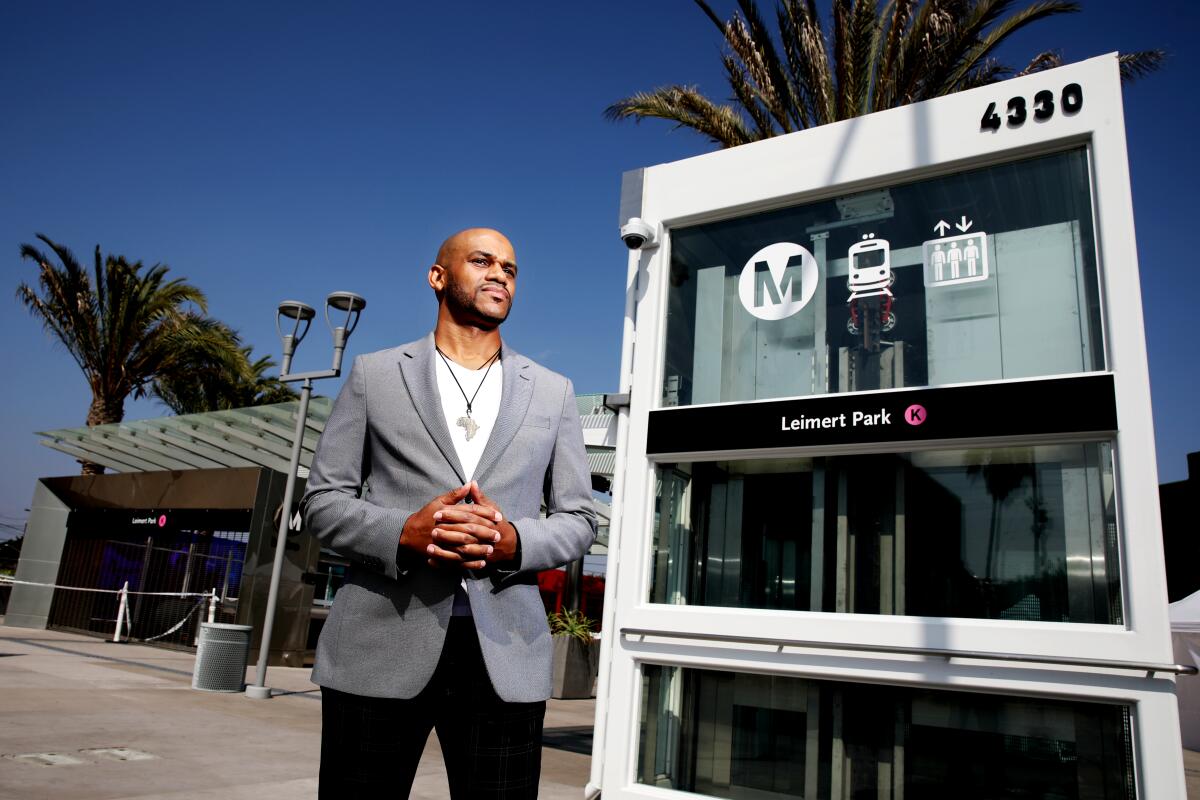
Although he spent years working to get a stop in Leimert Park, he eventually turned his efforts to slowing the march of development that the line would bring. He leads Downtown Crenshaw Rising, a nonprofit that sought to buy the mall.
He said the rail line has already created a “hyper-commodified” housing market where investment is poised to displace many in the very community that fought for it.
Goodmon is now part of the Liberty Community Land Trust, a nonprofit that purchases local commercial and residential properties to prevent that from happening. The money comes, in part, from his group’s failed bid for the plaza.
The trust has bought two commercial properties in Leimert Park and is eyeing other rentals, but its footprint is small compared with outside investment streaming in. Looking back, he said, he wished he had pushed for more protections for residents to fend off speculation and to stabilize rents.
“If you can’t put those protections in place, you shouldn’t be doing it.”
Anastasia Loukaitou-Sideris, a professor of urban planning at UCLA, studied census tracts near transit stations in a dozen California communities over a 20-year period and found fears of displacement were often realized. Working with UC Berkeley city and regional planning professor Karen Chapelle, she found those census tracts closest to the stations were much more likely to gentrify, especially if they were already seeing rising housing prices.
“I call this a little bit the dark side of transit-oriented development, because overall, transit-oriented development and building near transit stations can do a lot of good things,” Loukaitou-Sideris said. “It is not that we should not have transit stations. It is that we really need strategies for people to avoid displacement.”
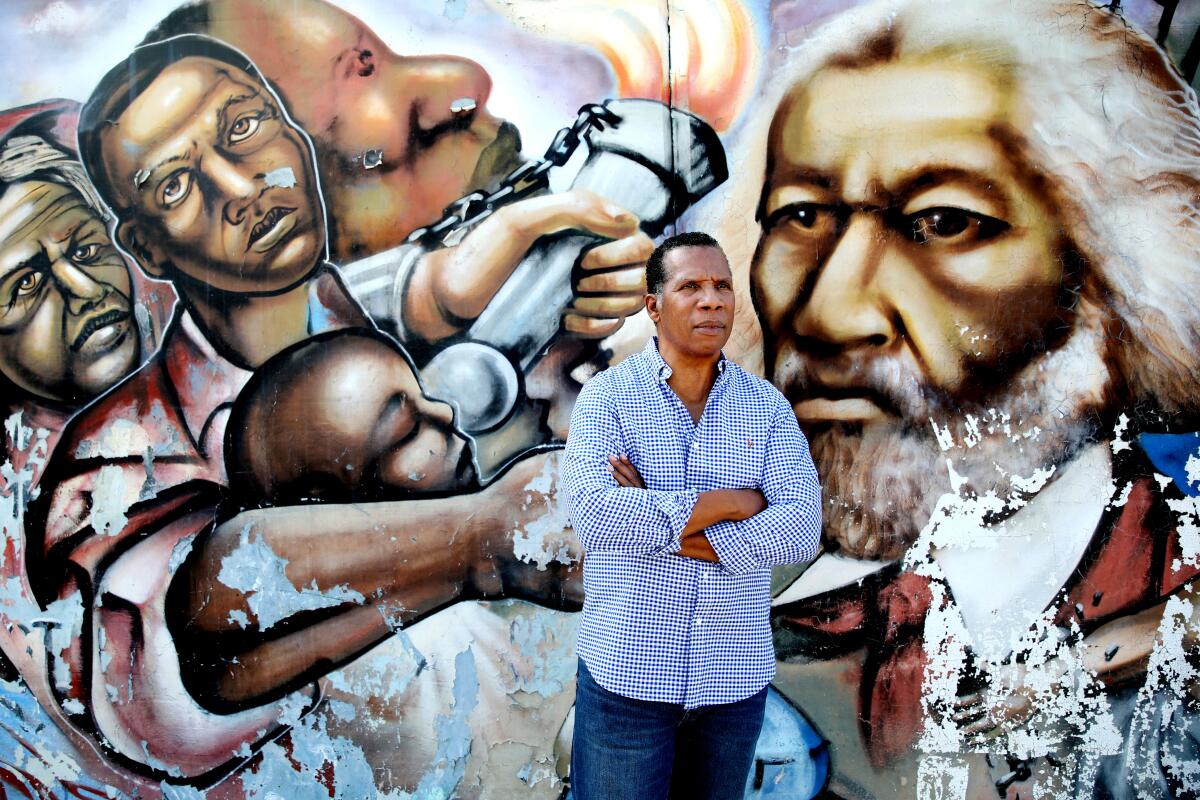
The K Line, three years late and more than $90 million over budget, was promoted after the Rodney King uprising more than 30 years ago as a way to bring opportunities to South Los Angeles, an area historically neglected by both city government and private investors.
But it took policymakers decades to secure the funding and finish planning it. And when they did, there were critics who called it a line to nowhere, arguing that it didn’t connect major job centers or shopping districts. Others wanted the line to go underground to prevent disruptions.
The rail line runs from the West Adams district to Westchester, and will eventually arrive in the South Bay. It broke ground in 2014 and was set to be completed in 2019, but it was beset by an array of problems. Neighbors complained of construction disruptions.
“This line is a promise long deferred to the people of Los Angeles and South Los Angeles,” said Inglewood Mayor James Butts.
From the northern end, the train starts underground at the Expo Line station next to the towering megachurch West Angeles Church of God and continues south under Crenshaw to the stop at Martin Luther King Jr. Boulevard, where the mall is. Next stop is Leimert Park, the cultural and commercial center of Black life in Los Angeles. Continuing on, the train pops up at street level just north of the Hyde Park station, where a Nipsey Hussle mural adorns a nearby bank. The tracks follows an old railway easement to a stop at Fairview Heights and into downtown Inglewood, where transit officials hope to link a monorail that will connect SoFi Stadium to the rest of the system. It goes on to Westchester/Veterans station, where it ends for now. It will eventually provide a connection to the airport, Century Boulevard and the Green Line.
The Crenshaw line is one of several public transit projects officials hope to open ahead of the 2028 Olympic Games as the Los Angeles County Metropolitan Transportation Authority undertakes the nation’s largest public transit construction plan. And it’s one that officials hope will help push transit ridership to pre-pandemic levels.
“This becomes a game changer that de-isolates South L.A.,” said Los Angeles Mayor Eric Garcetti.
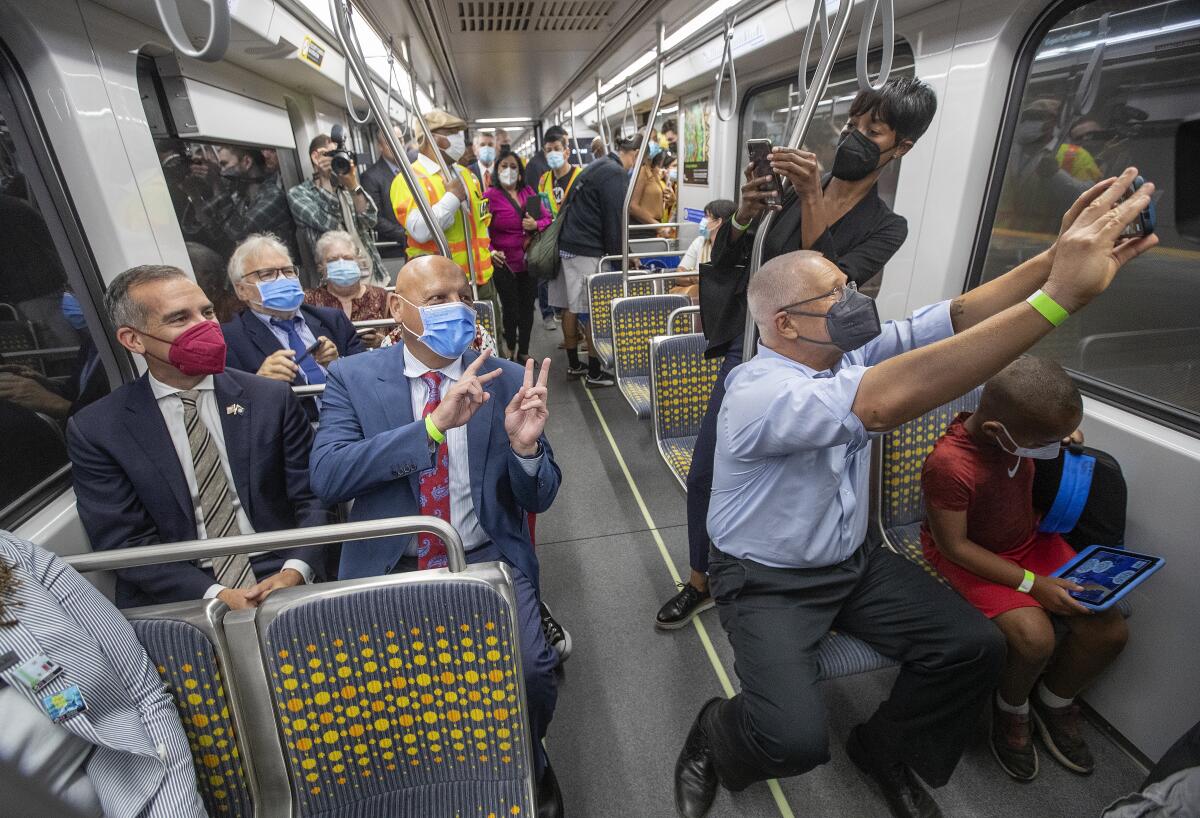
When the train opens, Metro plans on placing dozens of so-called ambassadors on the line, unarmed employees aimed at deterring crime and making people feel welcome.
“It’s fundamentally part of our rail revolution,” said Metro Chief Executive Stephanie Wiggins. “We are really building out our rail system so that we can actually develop a network.”
The agency has implemented measures to help the community, Wiggins said, including jointly developing housing 500 units, a good portion of which will be affordable, signing a labor agreement for local hires, and donating $20.1 million to help 230 small businesses interrupted by nearly a decade of construction.
By 2035, the line is estimated to draw 32,000 daily weekday passengers.
Can transit officials make buses and trains safer without more police? A new program will put 300 unarmed ambassadors as violence rises on the system.
As the Black population of South Los Angeles ebbed over the decades, the areas around Leimert Park and Hyde Park remained majority Black and a key source of political power, while becoming a cultural hub for Black poets, musicians, writers, artists and activists.
“It’s a place that had tremendous cultural significance,” said Manuel Pastor, who co-authored “South Central Dreams,” about the shifting demographics in South Los Angeles. “Particularly over the last 20 years, as the Black population has gotten smaller within the broader South L.A. area.”
Pastor said the rail line could lead to further gentrification, but could also have an upside by bringing together sometimes siloed parts of the city.
“It’s going to take a part of L.A. that should be better known to a lot of people ... and it’s going to make it an attractive place to visit, but also to live.”
One attraction community leaders are banking on is Destination Crenshaw, a monument to Black L.A. that flanks the rail line for 1.3 miles with rotating and permanent art exhibitions. The space will celebrate the community’s past, present and future.
“Black culture and art is what makes the Black community in particular irreplaceable,” said City Councilman Marqueece Harris-Dawson. The “Crenshaw district and the Black community are strong enough to hold the culture of that space throughout the turmoil that’ll come with new people and new ideas and new interests.”
The shifts are already clear for Fortson and others who live in the neighborhood. A woman from Beverly Hills recently stopped by Fortson’s market to pick up Caribbean food — a prospect she would never have imagined years ago, when the boulevard was still a place for young people to cruise.
“For 20 years, there was no interest. There was no investment. There was no job creation. Nothing,” said Greg Dulan, 63, whose Dulan’s on Crenshaw soul food restaurant sits along the line. He opened his business months after the 1992 riots and has seen the ups and downs. “With the train it seems like the last five years in particular, there has been an intensity that none of us anticipated. The properties have been snatched up.”
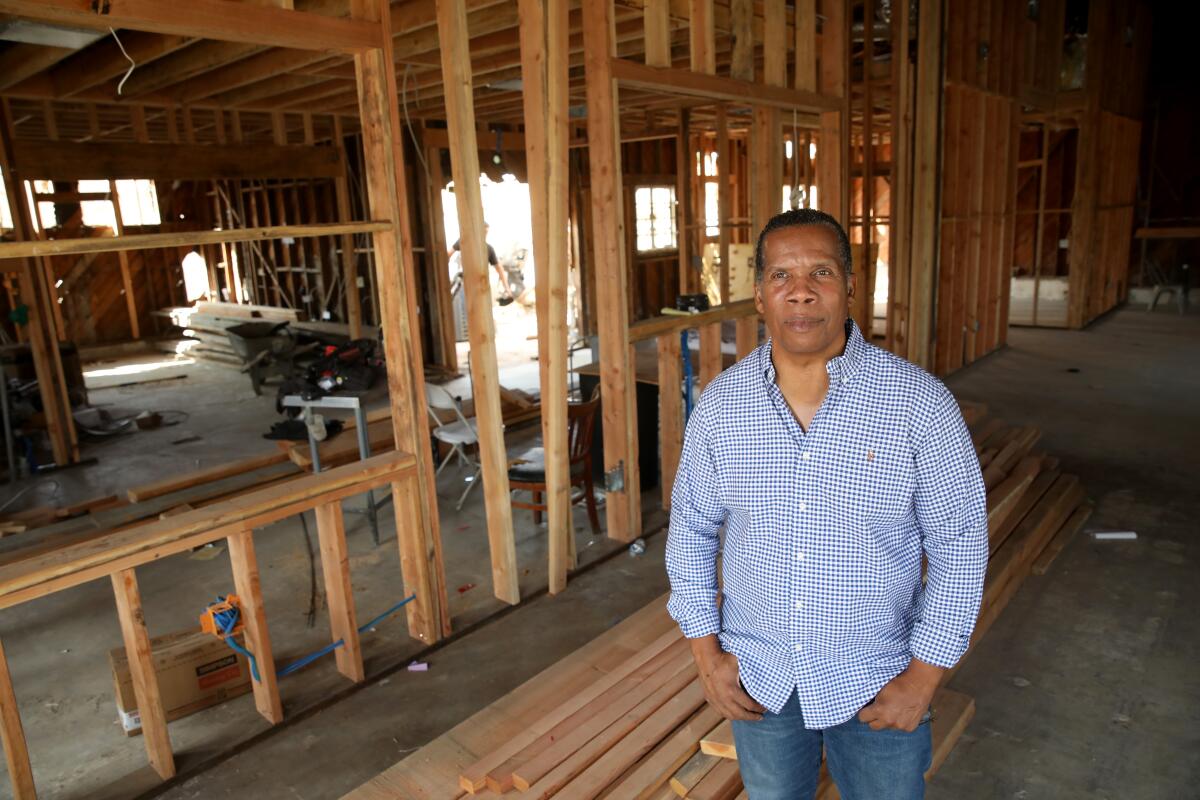
Dulan has counted about 2,500 new units planned within a two-mile radius of his restaurant. To stay afloat during construction, he took advantage of grants from Metro and is sinking hundreds of thousands of dollars into his 1950s-era spot to build a new kitchen, patio and parking lot.
“I have mixed emotions,” he said. “I think that it’s going to change the community in a lot of ways, from traffic to the mix of the neighborhood. ... And it’s going to bring more businesses more business opportunities.”
Looking to historically Black communities such as Harlem, N.Y., and Washington, D.C., Dulan sees a glimpse of what’s to come in his neighborhood. There, the old housing stock has been razed for denser housing for paler residents. Based on the rising equity of his property and with the help of a small-business loan, Dulan has been able to purchase a former preschool next to his restaurant that he’s made his office. It’s both a way to create generational wealth for his new grandson and to preserve the Black legacy in the city.
“My plan is to compete and stay and to survive and to thrive,” he said, peering out the restaurant’s window. “And be a part of the future Los Angeles that includes this new beautiful train that just went by.”
- Share via
Watch L.A. Times Today at 7 p.m. on Spectrum News 1 on Channel 1 or live stream on the Spectrum News App. Palos Verdes Peninsula and Orange County viewers can watch on Cox Systems on channel 99.
More to Read
Sign up for Essential California
The most important California stories and recommendations in your inbox every morning.
You may occasionally receive promotional content from the Los Angeles Times.

